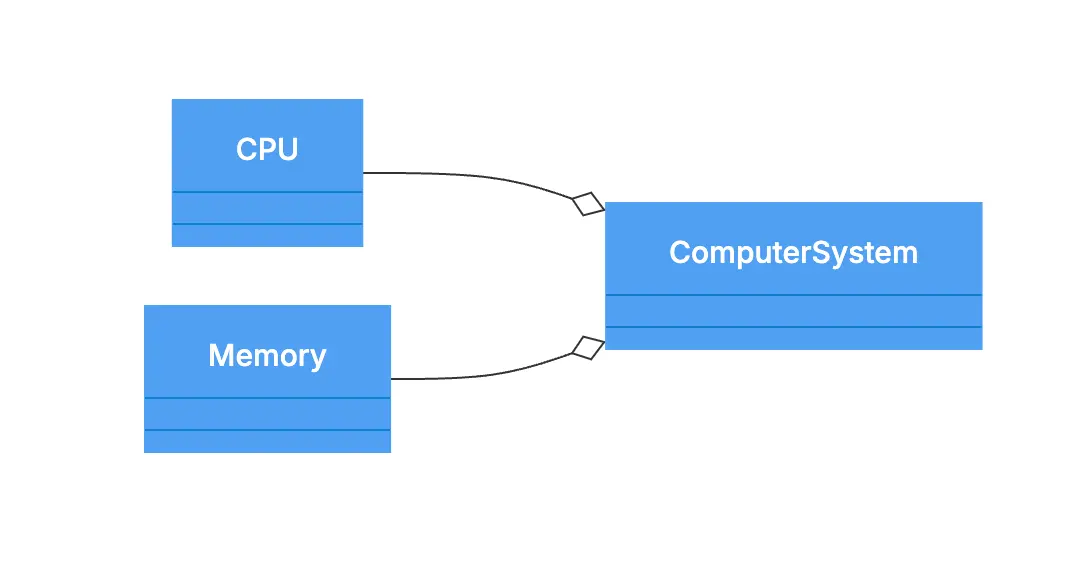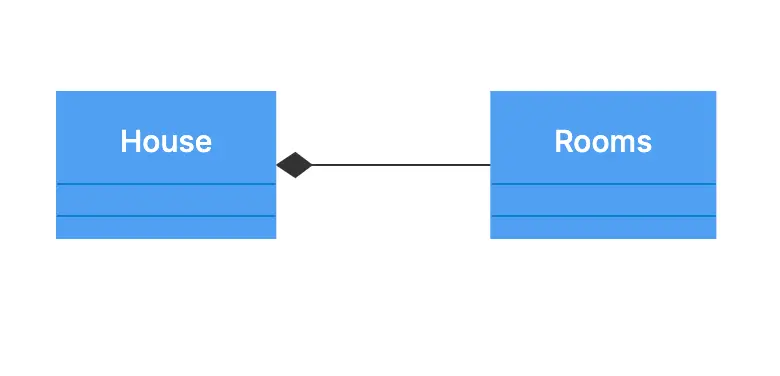The Unified Modeling Language (UML) is a foundational tool in software development, offering a standardized way to visualize system designs. Beyond mere diagramming, UML is used for detailed project planning, facilitating clear communication among project stakeholders. Its core value lies in modeling the relationships between system components, important for defining interactions, data sharing, and responsibility delegation within object-oriented design.
Central to UML's effectiveness is its capacity to illustrate different types of associations, notably aggregation and composition. These concepts are vital for understanding how objects relate to one another, influencing the system’s structure and behavior. Accurately representing these relationships allows for logical, coherent designs that meet project requirements effectively. Let's see how it works.
Read an overview of UML relationships.
Understanding Aggregation in UML
Aggregation is a specialized form of association in the UML that represents a "has-a" or "whole/part" relationship between the aggregate (the whole) and its parts, signifying a weak ownership between them. This relationship suggests that while the aggregate may contain or be composed of its parts, these parts can exist independently of the aggregate. It is this independence that characterizes aggregation and distinguishes it from other types of associations.
Characteristics of Aggregation
Weak Ownership: The life cycle of the parts is not tightly coupled to the life cycle of the aggregate. If the aggregate is destroyed, its parts can continue to exist.
Binary Relationship: Aggregation typically involves two classes where one class is a container, and the other class is contained.
Shared Relationships: The contained objects can be part of multiple aggregates.
Transitivity: If Class A contains Class B, and Class B contains Class C, Class A does not necessarily contain Class C.
Examples of Aggregation in Real-world Scenarios
Library and Books: A library can have an aggregation relationship with books. The library (whole) contains books (parts), but the books are not dependent on the library for their existence. They can be found in other libraries or owned individually.

Computer System: In a computer system, a computer (aggregate) may have components like a CPU and memory (parts). These parts are integral to the computer's functioning but can exist independently outside of the computer system.

In UML diagrams, aggregation is depicted by a hollow diamond shape at the aggregate end of the line that connects it to its part. This visual representation helps in quickly understanding the nature of the relationship between system components, making it easier for developers and stakeholders to grasp complex designs.
Understanding Composition in UML
Composition in the UML represents a strong form of the "has-a" or "whole/part" relationship, characterized by a strong ownership and a coincidental lifecycle between the whole and its parts. This means that the parts are created when the whole is created and destroyed when the whole is destroyed. Composition implies a more rigid relationship than aggregation, highlighting an inseparable relationship where parts do not have an independent existence without the whole.
Characteristics of Composition
Strong Ownership: The whole is responsible for the creation and destruction of its parts. The lifecycles of the parts are tightly coupled with the lifecycle of the whole.
Exclusive Containment: Each part is contained in only one whole at a time and cannot be shared among multiple wholes.
Transitive Containment: If a whole contains another whole that in turn contains parts, those parts are also considered parts of the top-level whole.
Binary Relationship: Similar to aggregation, composition involves two classes; however, in composition, the link between the whole and the part is stricter and more dependent.
Examples of Composition in Real-world Scenarios
Human and Heart: A human being can be considered a whole, with the heart as a part. The heart does not exist independently of the human body, and its lifecycle is inherently tied to that of the human, illustrating a composition relationship.

House and Rooms: A house (the whole) consists of several rooms (the parts). The rooms are integral to the structure of the house and do not exist separately from it. When the house is demolished, the rooms cease to exist as well.

In UML diagrams, composition is depicted by a filled diamond shape at the whole end of the line connecting it to its parts. This notation serves as a quick visual cue for the strong relationship and dependency between the components.
Aggregation vs Composition: Key Differences
When modeling relationships in UML, distinguishing between aggregation and composition is crucial for accurately representing the interactions and dependencies between objects. These relationships differ primarily in terms of ownership, lifecycle, and their application within system designs. Understanding these differences helps in making informed decisions about system architecture and in answering common queries such as whether aggregation is stronger than composition.
Ownership
As was already discussed, Aggregation implies a weak ownership where the parts can exist independently from the whole. It represents a relationship where the whole may contain parts, but these parts are not exclusively linked to the whole.
Composition, on the other hand, signifies strong ownership. The parts are tightly integrated into the whole, and their existence is solely dependent on the whole they are part of.
Lifecycle
In aggregation, the lifecycle of the parts is separate from that of the whole. Parts can be created and destroyed independently of the whole.
Composition dictates that the lifecycle of the parts is wholly dependent on the whole. If the whole is destroyed, the parts are also destroyed. This reflects a more dependent and exclusive relationship between the whole and its parts.
When to Use Each
Aggregation is ideal for relationships where components need to maintain their independence or be shared across different aggregates. It’s suitable for non-exclusive relationships where the parts have their own identity and lifecycle outside the whole.
Composition should be used for relationships where components are intrinsically linked to the whole, with no independent existence or shared ownership. This is appropriate for scenarios where parts must not outlive the whole.
Addressing the question: Is aggregation stronger than composition?
The question of whether aggregation is stronger than composition arises from a misunderstanding of these relationships. In reality, the strength of these associations is not a matter of one being stronger than the other; rather, it's about the nature of the dependency between the whole and its parts. Composition represents a stronger dependency and ownership by the whole over its parts, whereas aggregation allows for more flexibility and independence of parts. The choice between aggregation and composition depends on the specific requirements of the system design and the intended lifecycles of the components involved.
Read also: UML Dependency: Managing Relationships in Software Design
In summary, while both aggregation and composition play substantial roles in UML diagrams for defining the nuances of object relationships, their application is dictated by the desired degree of coupling and independence among system components. Correctly applying these relationships enhances the clarity, integrity, and flexibility of system designs.
Boosting Design Potential with UML and Gleek App
For those looking to implement these concepts in their designs, tools like Gleek app offer a straightforward and efficient means of creating UML diagrams. Gleek app simplifies the process of visualizing complex relationships, making it accessible for users to model both aggregation and composition within their systems. Its intuitive interface and powerful features facilitate the quick drafting of diagrams, helping to bring theoretical designs to life.
We encourage designers, developers, and architects to deepen their understanding of these essential object-oriented principles by putting them into practice. Creating UML diagrams with the Gleek app can be an excellent start. This hands-on approach not only solidifies one's comprehension of aggregation and composition but also enhances one's overall design skills.
Experience the power of effective system modeling by creating your first UML diagram with the Gleek app. Explore how aggregation and composition can be visualized and applied in your projects, paving the way for more robust and coherent designs.
Related posts
State diagram for student registration process with Gleek app
Sequence diagram for library management system
Mastering inheritance in class diagrams
Restaurant management system class diagram from scratch
What is multiplicity in a class diagram?
Sequence diagram fragments: loop, alternative, option
How do we create a Class diagram for a Library Management system?
